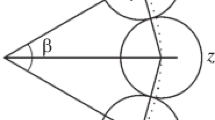Abstract
Quotient spaces of Keplerian orbits are important instruments for the modelling of orbit samples of celestial bodies on a large time span. We suppose that variations of the orbital eccentricities, inclinations and semi-major axes remain sufficiently small, while arbitrary perturbations are allowed for the arguments of pericentres or longitudes of the nodes, or both. The distance between orbits or their images in quotient spaces serves as a numerical criterion for such problems of Celestial Mechanics as search for common origin of meteoroid streams, comets, and asteroids, asteroid families identification, and others. In this paper, we consider quotient sets of the non-rectilinear Keplerian orbits space \(\mathbb H\). Their elements are identified irrespective of the values of pericentre arguments or node longitudes. We prove that distance functions on the quotient sets, introduced in Kholshevnikov et al. (Mon Not R Astron Soc 462:2275–2283, 2016), satisfy metric space axioms and discuss theoretical and practical importance of this result. Isometric embeddings of the quotient spaces into \(\mathbb R^n\), and a space of compact subsets of \(\mathbb H\) with Hausdorff metric are constructed. The Euclidean representations of the orbits spaces find its applications in a problem of orbit averaging and computational algorithms specific to Euclidean space. We also explore completions of \(\mathbb H\) and its quotient spaces with respect to corresponding metrics and establish a relation between elements of the extended spaces and rectilinear trajectories. Distance between an orbit and subsets of elliptic and hyperbolic orbits is calculated. This quantity provides an upper bound for the metric value in a problem of close orbits identification. Finally the invariance of the equivalence relations in \(\mathbb H\) under coordinates change is discussed.
Similar content being viewed by others
References
Burago, D., Burago, Y., Ivanov, S.: A course in metric geometry, vol. 33. American Mathematical Society, Providence (2001)
Carruba, V., Nesvornỳ, D., Aljbaae, S.: Characterizing the original ejection velocity field of the Koronis family. Icarus 271, 57–66 (2016)
Drummond J.D.: On the meteor/comet orbital discriminant d. In: Southwest Regional Conference for Astronomy and Astrophysics, 5, vol 5, pp 83–86 (1980)
Edgar, G.: Measure, Topology, and Fractal Geometry. Springer, New York (2008)
Kelley, J.L.: General Topology. The University Series in Higher Mathematics. D. Van Nostrand Company, Inc, New York (1955)
Kholshevnikov, K.V.: Metric spaces of Keplerian orbits. Celest. Mech. Dyn. Astron. 100(3), 169–179 (2008)
Kholshevnikov, K.V., Kokhirova, G.I., Babadzhanov, P.B., Khamroev, U.H.: Metrics in the space of orbits and their application to searching for celestial objects of common origin. Mon. Not. R. Astron. Soc. 462, 2275–2283 (2016)
Kholshevnikov, K.V., Kokhirova, G.I., Khamroev, U.H.: New approaches to measure the orbital similarity and its application to related objects. Planet Space Sci (2018) (under review)
Klacka, J.: Meteor stream membership criteria. ArXiv preprint arXiv:astro-ph/0005509 (2000)
Kryszkiewicz, M., Lasek, P.: Ti-dbscan: clustering with dbscan by means of the triangle inequality. In: International Conference on Rough Sets and Current Trends in Computing, Springer, pp 60–69 (2010)
MacQueen, J., et al.: Some methods for classification and analysis of multivariate observations. In: Proceedings of the fifth Berkeley Symposium on Mathematical Statistics and Probability, Oakland, CA, USA 1, pp. 281–297 (1967)
Maruskin, J.M., Scheeres, D.J.: Metrics on the space of bounded keplerian orbits and space situational awareness. In: Proceedings of the 48th IEEE Conference on Decision and Control, 2009 held Jointly with the 2009 28th Chinese Control Conference, CDC/CCC 2009, IEEE, pp. 5912–5917 (2009)
Maruskin, J.M.: Distance in the space of energetically bounded keplerian orbits. Celest. Mech. Dyn. Astron. 108(3), 265–274 (2010)
Southworth, R.B., Hawkins, G.S.: Statistics of meteor streams. Smithson. Contrib. Astrophys. 7, 261 (1963)
Stiefel, E.L., Scheifele, G.: Linear and Rgular Celestial Mechanics: Perturbed Two-Body Motion, Numerical Methods, Canonical Theory, Grundlehren der mathematischen Wissenschaften. Springer, Berlin (1971)
Zappala, V., Cellino, A., Farinella, P., Knezevic, Z.: Asteroid families identification by hierarchical clustering and reliability assessment. Astron J 100, 2030–2046 (1990)
Acknowledgements
We are grateful to Professor K. V. Kholshevnikov for the statement of the problem and important remarks. We also thank unknown reviewers and the editor for detailed analysis and valuable suggestions. This work is supported by the Saint Petersburg State University, research Grant 6.37.341.2015.
Author information
Authors and Affiliations
Corresponding author
Rights and permissions
About this article
Cite this article
Milanov, D.V. Metrics in Keplerian orbits quotient spaces. Celest Mech Dyn Astr 130, 27 (2018). https://doi.org/10.1007/s10569-018-9820-1
Received:
Revised:
Accepted:
Published:
DOI: https://doi.org/10.1007/s10569-018-9820-1



